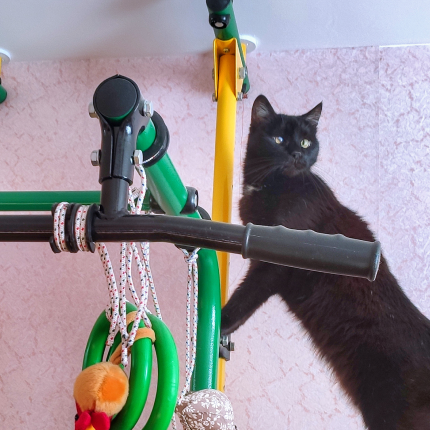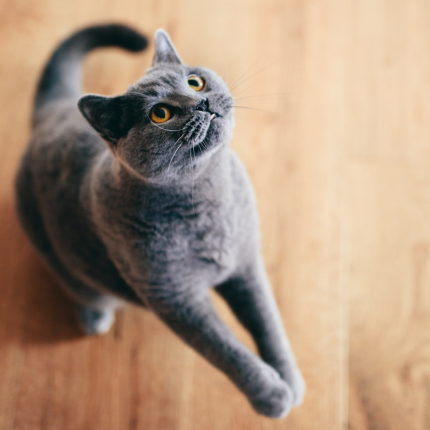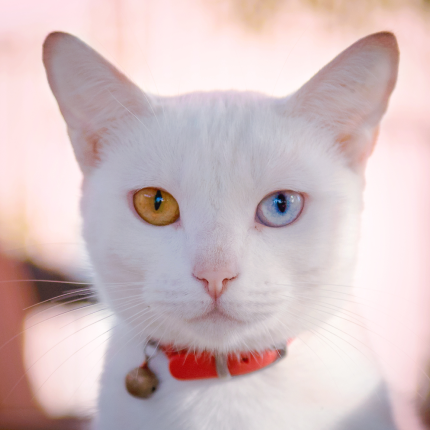Ways To Help Your Cat Lose Weight

Overweight cats make up more than half of all pet cats. And, while it’s easy to dismiss a few extra ounces as just extra-fluffy fur, excess fat has serious consequences. Whether it’s the risk of a shorter lifespan, an increased risk of health problems, or simply mobility issues, even a few extra pounds can significantly impact your cat’s health.
advertisement
Why Do a Few Pounds Matter?
When your veterinarian says your cat could lose two pounds or so, it’s easy to dismiss the importance of weight loss. After all, two pounds make little difference to humans. But, with the average cat weighing 10 pounds, two pounds is a substantial issue!
Consider the average 160-pound person versus the average 10-pound cat. Two pounds on that cat is the same as 32 pounds on that 160-pound human. And if the average cat had an excess of three pounds, that equates to nearly 50 pounds of excess weight on a human frame.
Choosing How Much Weight to Lose
Humans frequently refer to weight loss in terms of pounds because we often use weight-based guidelines to determine our ideal body type. However, BMI charts and other procedures that work for most humans do not work for cats. We recommend using body condition scoring to determine the best body type for a cat.
Body condition scoring for cats is on a scale of 1-5 or 1-9. If your cat scores above the ideal range, a scale can help track monthly weight loss goals, but you should still use the visual check as you approach your cat’s goal.
Cats with a healthy weight are generally happier, more agile, and live longer. So if you work with her, your fat cat can become a small, lean, ribbon-chasing machine this year. Here are our top suggestions for this year to help your cat reduce weight.
Vet Visits & Food Intake
The optimal initial step is to discuss your pet’s health with the veterinarian. They will be able to aid you in identifying the beginning point for your cat as well as any health issues that may hinder the development process.
- Look into diet food:
There are “diet” cat food varieties; you read that right! If you decide to switch, you should do so gradually over about two weeks so that your cat does not go on a hunger strike. The new foods typically have fewer calories and more nutrients than the old ones.
- Keep track of your caloric intake:
Did you know that the average indoor cat only needs 20-30 calories per pound of body weight per day? Examine your cat’s current diet’s nutritional value to see how it compares to others, and start measuring the food at each meal.
- L-Carnitine should be added:
Several studies have shown that L-Carnitine supplements boost cats’ metabolism by interacting with fatty acids in their liver to help convert fat cells into energy. Consult your veterinarian to determine whether L-Carnitine (or other supplements) is appropriate for your cat.
- Canned products:
Is it possible that canned food could be healthier? Cats seem to like food that comes in cans, and the regulated serving sizes make it less likely that they will be overfed. Make sure you verify the calorie count before you make any purchases!
- Remove the treats.
We are aware! Your cats enjoy treats. However, they can conceal a significant amount of calories, and most pet owners feed them multiple times daily. Don’t even get us started on giving your human-cat food in exchange for treats.
Exercising
Move her food to a new location every time you feed your cat. The thrill of the hunt will enthrall her, and she’ll also get some extra exercise by searching the premises.
- Think about a feeding ball.
If your cat prefers dry food, invest in a feeding ball that does her work for each nugget. She’ll have fun pushing the ball around and get much more exercise.
- Produce more “bursts.
” Cats, unlike dogs, are designed to exercise in short, anaerobic bursts rather than in long stretches. Mini-play sessions throughout the day are the most effective way to accumulate more.
- Add some excitement to playtime.
Lazy cats rarely find ways to occupy themselves. A simple string on a rope, some foil balls, or a laser pointer may turn into a quick and enjoyable game that brings people together.
- You should go for a walk with your pet.
Because they prefer being outside, some cats enjoy walking on a leash because it allows them to do so. It would help if you got some inside practice before venturing into the vast unknown together.
- Maintain the flow of water:
Your cat may act “hungry” when she is bored. If playtime isn’t working, bring out a new bowl of water to give her something to drink.
- Set up some climbing structures.
Is your cat a climber? Perhaps she would be if she had a climbing wall! Providing low-intensity exercise options for your cat may encourage her to move more than you think.
advertisement
Ignore their beseeching
- It’s difficult to ignore a begging cat! By sticking to the feeding schedule and not overfeeding, you can be confident that you are doing what is best for her. Instead of giving your cat a tasty treat, cuddle, play, or pet her.
- Examine your progress. If your cat is losing weight, you should be able to tell by observing her physical size, the ease with which she moves, and her stamina level. In addition, make it a habit to check her weight every month; if she hasn’t shed between 0.5 and 1 pound in the first month, the diet needs to be altered.
- Talk things over with your pet’s vet (again.) Maintaining a steady routine is essential to successful weight loss! Talk to your cat’s veterinarian about the various dangers that could affect your cat as she gets older, as well as the things you can do regularly to ensure that your cat leads a healthier and more fit life.

Featured Articles

Greebles and Cats: The Origin and the Meaning
You may have seen an internet sensation concerning cats labeled “greebles.” Feel out of the loop? We’re here to help you. In 2019, Reddit user /user/literallyatree commented on a Reddit post about a cat that looks like it’s trying to slap a ghost. This user commented: “My family calls things…

The Odd-Eyed Cat (AKA Heterochromia)
Cats are already beautiful and fascinating creatures, but people are bound to take notice when they have something as captivating as two different colored eyes. Odd-eyed cats always have one blue eye paired with either a green, yellow, or brown eye. This form of heterochromia occurs in other animals, including…

Polydactyl Cats: Just More Beans to Love
Polydactyl cats have become extremely popular in recent times. As a result, more and more people are interested in learning more about this six-toed cat and want to get one of their own. If you are a cat lover intrigued by polydactyl cats, you have come to the right place….
